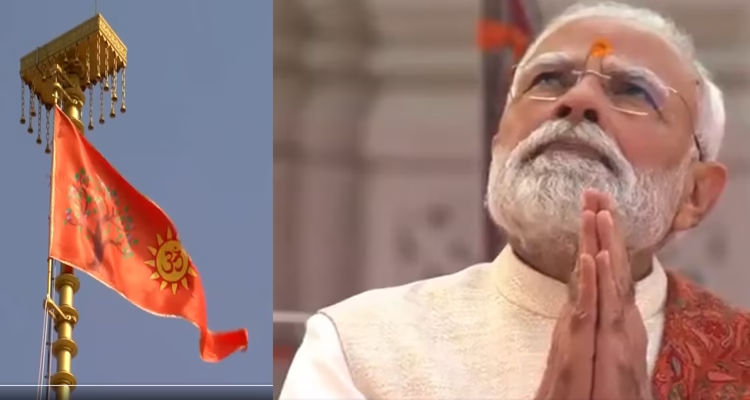
PM Modi Hoists ‘Dharma Dhwaja’ Atop Ram Mandir, Marking a Civilisational Moment in Ayodhya
Ayodhya: Prime Minister Narendra Modi on Tuesday hoisted the “Dharma Dhwaja” atop the towering shikhara of the Ram Mandir, in a visually and emotionally charged ceremony that devotees and organisers described as the final, crowning gesture of the temple’s completion. The moment unfolded under Vedic chants, the blowing of conch shells, and a dramatic shower of flower petals released from circling helicopters, as thousands watched inside and millions more followed on livestreams across India.
#WATCH | Ayodhya Dhwajarohan | PM Modi and RSS Sarsanghchalak Mohan Bhagwat ceremonially hoist the saffron flag on the Shikhar of the sacred Shri Ram Janmbhoomi Temple, symbolising the completion of the temple’s construction.
The right-angled triangular flag, measuring 10 feet… pic.twitter.com/Ip8mATz2DC
— ANI (@ANI) November 25, 2025
A Sacred Flag Designed for Eternity
No ordinary flag, the Dharmic emblem is a feat of symbolism, engineering and historical research:
-
22 feet long, 11 feet wide, mounted on a 42-foot pole attached to the 161-foot main spire.
-
Equipped with a superior 360-degree rotating bearing system, allowing the flag to align with the wind and maintain its posture.
-
Woven from silk threads combined with parachute-grade material, ensuring durability against sun, storms and humidity, with input from military experts on endurance standards.
-
Manufactured in Ahmedabad by a specialist company that normally produces aerospace-grade parachutes—chosen for precision requirements rather than decorative aesthetics.
Simply put, this is a flag built to withstand the elements for decades, if not centuries—an emblem intended to remain permanently visible in the Ayodhya skyline.

The Language of Symbols: Om, Sun and Kovidara
The flag carries three sacred visual motifs:
-
Om — representing the eternal cosmic vibration, the primordial sound of creation.
-
The Sun — signifying Lord Ram’s royal lineage from the Suryavanshi dynasty and the luminosity of righteous leadership.
-
The Kovidara Tree — tied to ancient lore involving Rishi Kashyap and associated with early Indian botanical traditions, symbolising fertility, knowledge, and generative transformation.
These motifs were not arbitrarily selected—they were reconstructed via research into old illustrated Ramayana manuscripts, including Mewar-era depictions, and by studying textual references in portions of the Valmiki Ramayana. In effect, the Dharma Dhwaja is a revival of an ancient flag design that once adorned temples and royal insignia linked to Lord Ram.
Ritual Precision: A Ceremony Timed to the Minute
The spiritual gravity of the event was reflected in its careful orchestration:
-
The auspicious window—the shubh muhurat—fell between 11:52 am and 12:35 pm.
-
The actual act of hoisting the flag took less than four minutes, timed exactly to the prescribed planetary alignment.
-
Twenty-one Vedic acharyas conducted the rites, while conch shells sounded to welcome the sacred ascent of the flag.
-
As the Dhwaja unfurled, petals rained from above, completing a scene both dramatic and devotional.
During the ceremony, the temple remained closed for ordinary devotees—only invited attendees were permitted entry.
Who Was Present: A Microcosm of Indian Society
About 6,000–7,000 guests were invited, representing:
-
Diverse social groups
-
Rural families associated with the temple movement
-
Industrialists and donors
-
Spiritual leaders and saints
-
Academics and cultural historians
-
State representatives and local dignitaries
Inside the temple complex, seating was arranged in 15 blocks named after revered Rishis, reinforcing continuity with India’s spiritual genealogies. A massive 200-foot LED screen ensured that even those seated afar had a clear view of the sacred moment.
A Date Heavy with Meaning: Panchami of Margashirsha
The choice of November 25 was intentional—not logistical but mytho-historical.
According to tradition, Lord Ram and Sita were married on Panchami, the fifth day of Shukla Paksha in the month of Margashirsha in Treta Yuga. Choosing that same Panchami linked the Dhwajarohan with the celestial timeline of Ramayana history, making the occasion not just celebratory, but cosmologically aligned.
Priests associated with the event described the moment as the ritual “marriage” of the finished temple with its eternal identity under the Dharma Dhwaja.
Leaders Speak of a ‘New Cultural Era’
Following the hoisting, Prime Minister Modi, RSS chief Mohan Bhagwat and UP CM Yogi Adityanath participated in the concluding rituals.
The overarching tone of the ceremony was not political, but civilisational.
-
For Yogi Adityanath, the temple and its new flying standard signal a renaissance of Ayodhya and a moral-cultural resurgence.
-
For Mohan Bhagwat, the Dhwaja represents a long-sought fulfillment—the return of Ram to his rightful symbolic place.
-
For PM Modi, this ceremony followed earlier milestones he led—most notably the Pran Pratishtha—and symbolised the completion of a promise spiritually rooted in centuries of devotion.
More Than a Flag — A Marker of Presence
In traditional dharma texts, a temple flag is more than cloth—it is a declaration of divine presence. It signals that beneath it lies consecrated ground, a site of active spiritual energy.
With the Dharma Dhwaja now visible across Ayodhya, many believers view it as both:
A beacon inviting devotees
And a banner marking the restoration of memory, faith and heritage
From a historic dispute to a monumental construction to a sanctified completion, the Ram Mandir now stands not merely as an architectural marvel, but as a living religious and cultural axis—with the Dharma Dhwaja fluttering at its summit, binding past, present and future in saffron silk.



